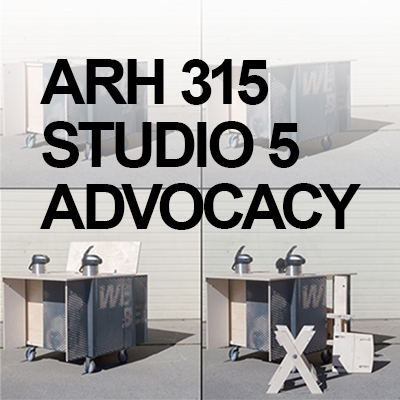
ARH 315 STUDIO 5 ADVOCACY IN DESIGN
Take a stance on the role of architecture in our urban environments. Through the design of a public building, you’ll advocate for and engage with under-served communities. Your honest inquiry of the urban fabric and the diversity of its inhabitants will create a responsive, empathetic program and a building proposal. In this Midpoint Review Studio, you will develop your academic portfolio to highlight your skills and progress.
Prerequisites: ARH 180, ARH 239, ARH 255, LA 292 and one of the following LA 219, LA 249, LA 319 (LA 292 may be taken concurrently)
Course Learning Outcomes
- Produce diagrams indicating critical analyses of users, programmatic typologies, and architectural precedents.
- Develop and evaluate design strategies through criteria and iterative making in alignment with program research and stance.
- Build an accurate and optimized digital model of the project.
- Articulate work for both designers and non-designers, using appropriate graphic, written, and verbal language
- Develop program and architectural proposals sensitive to both the user and the context through an empathetic engagement with under-served populations.
- Produce architectural drawings with correct drawing conventions to convey spatial qualities and design intent.
- Apply structural understanding of the design exhibited consistently in architectural plans and sections.
- Accommodate basic accessibility and life safety requirements in the design of a building.
NAAB Criteria
- This course addresses part of NAAB PC.8 Social Equity & Inclusion: How the program furthers and deepens students’ understanding of diverse cultural and social contexts and helps them translate that understanding into built environments that equitably support and include people of different backgrounds, resources, and abilities
- This course addresses NAAB Shared Values of Equity, Diversity & Inclusion: Architects commit to equity and inclusion in the environments we design, the policies we adopt, the words we speak, the actions we take, and the respectful learning, teaching, and working environments we create. Architects seek fairness, diversity, and social justice in the profession and in society and support a range of pathways for students seeking access to an architecture education
- This course addresses NAAB Shared Values of Leadership, Collaboration, and Community Engagement: Architects practice design as a collaborative, inclusive, creative, and empathetic enterprise with other disciplines, the communities we serve, and the clients for whom we work
Additional Information
Take a stance on the role of architecture in our urban environments. Through the design of a public building, you’ll advocate for and engage with under-served communities. Your honest inquiry of the urban fabric and the diversity of its inhabitants will create a responsive, empathetic program and a building proposal. In this Midpoint Review Studio you will develop your academic portfolio to highlight your skills and progress.
Homelessness, or the state of being unsheltered, does not have a simple solution, but instead is representative of a state that requires many, thoughtfully designed responses at different scales that encompass the sensitive nature of the human spirit. In this studio, we look at the housing crisis pervading San Francisco, resulting in record evictions, and an emergency of homelessness and affordability. To study this issue, we will consider a range of definitions of unsheltered, as defined in a city where the average rent for a 2 bedroom apartment is almost $5000 per month, and a salary of $117,400 is considered low income for a family of four. In this city, homelessness may mean you are employed but cannot afford rent, or that you got evicted as you had to spend all your income on medical bills. It could mean there isn’t enough room in the family home for you, or that you had a fight with a roommate and are unable to locate new housing.
Considering this expanded definition of homelessness, this studio emphasizes empathy to develop multiple-scaled solutions, each appropriate to its context. To tackle and research this, you will develop two proposals. The first considers the intimate scale and will use your interviews of a person experiencing homelessness to design an Individual Guerilla ___ Unit, which responds to his/her/their specific needs and desires. From this, you will develop a proposal for a shelter to house a demographic of your choice, with a bold design that strives to make a shelter that’s connected to its neighbors, is stigma free and part of a new equitable and vibrant housing prototype. And while a shelter represents a first step, humanity is not one note, but rather a symphony, and it is through interventions and conversations at both the intimate and building scales that this symphony is given a voice and audience.
Student Project By: Stella Buckmann de Lima Netto, Yuanyuan Chen, Pablo Delarosa, Raul Higuera, Woohyung Kim, Erick Luna, Wenjie Lie, Zed Malmoux, Benjy Michel, Adam Nuru, Andrae Rumal, Markish Siojo, Nahoua Christian Jean-Raymond Sorho, Carrarheina Tjoa, Francisco Toca-Madrid, Robert Villanueva, Bobby Wijaya, Yang Xi, Shuangrong Zhong
Student Project By: Katie Tablada, Meng Fan, Zoe Zheng, Juliana Bento, Sarah Berting, Rheina Tjoa
Student Project By: Connor Bowes
Student Project By: Astireh Baradari
Student Project By: Jose Pineda
